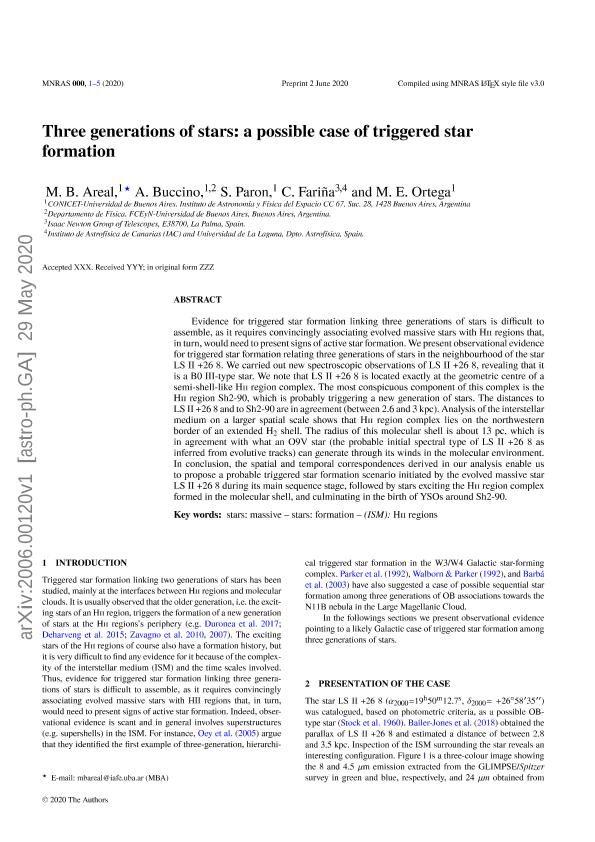Mostrar el registro sencillo del ítem
dc.contributor.author
Areal, María Belén

dc.contributor.author
Buccino, Andrea Paola

dc.contributor.author
Paron, Sergio Ariel

dc.contributor.author
Ortega, Martin Eduardo

dc.date.available
2022-08-02T00:47:49Z
dc.date.issued
2020-06
dc.identifier.citation
Areal, María Belén; Buccino, Andrea Paola; Paron, Sergio Ariel; Ortega, Martin Eduardo; Three generations of stars: A possible case of triggered star formation; Wiley Blackwell Publishing, Inc; Monthly Notices of the Royal Astronomical Society; 496; 1; 6-2020; 870-874
dc.identifier.issn
0035-8711
dc.identifier.uri
http://hdl.handle.net/11336/163781
dc.description.abstract
Evidence for triggered star formation linking three generations of stars is difficult to assemble, as it requires convincingly associating evolved massive stars with H ii regions that, in turn, would need to present signs of active star formation. We present observational evidence for triggered star formation relating three generations of stars in the neighbourhood of the star LS II +26 8. We carried out new spectroscopic observations of LS II +26 8, revealing that it is a B0 III-type star. We note that LS II +26 8 is located exactly at the geometric centre of a semi-shell-like H ii region complex. The most conspicuous component of this complex is the H ii region Sh2-90, which is probably triggering a new generation of stars. The distances to LS II +26 8 and to Sh2-90 are in agreement (between 2.6 and 3 kpc). Analysis of the interstellar medium on a larger spatial scale shows that the H ii region complex lies on the north-western border of an extended H2 shell. The radius of this molecular shell is about 13 pc, which is in agreement with what an O9 V star (the probable initial spectral type of LS II +26 8 as inferred from evolutive tracks) can generate through its winds in the molecular environment. In conclusion, the spatial and temporal correspondences derived in our analysis enable us to propose a probable triggered star formation scenario initiated by the evolved massive star LS II +26 8 during its main-sequence stage, followed by stars exciting the H ii region complex formed in the molecular shell, and culminating in the birth of young stellar objects around Sh2-90.
dc.format
application/pdf
dc.language.iso
eng
dc.publisher
Wiley Blackwell Publishing, Inc

dc.rights
info:eu-repo/semantics/openAccess
dc.rights.uri
https://creativecommons.org/licenses/by-nc-sa/2.5/ar/
dc.subject
H II REGIONS
dc.subject
STARS: FORMATION
dc.subject
STARS: MASSIVE
dc.subject.classification
Astronomía

dc.subject.classification
Ciencias Físicas

dc.subject.classification
CIENCIAS NATURALES Y EXACTAS

dc.title
Three generations of stars: A possible case of triggered star formation
dc.type
info:eu-repo/semantics/article
dc.type
info:ar-repo/semantics/artículo
dc.type
info:eu-repo/semantics/publishedVersion
dc.date.updated
2021-08-27T20:46:49Z
dc.journal.volume
496
dc.journal.number
1
dc.journal.pagination
870-874
dc.journal.pais
Reino Unido

dc.journal.ciudad
Londres
dc.description.fil
Fil: Areal, María Belén. Consejo Nacional de Investigaciones Científicas y Técnicas. Oficina de Coordinación Administrativa Ciudad Universitaria. Instituto de Astronomía y Física del Espacio. - Universidad de Buenos Aires. Facultad de Ciencias Exactas y Naturales. Instituto de Astronomía y Física del Espacio; Argentina
dc.description.fil
Fil: Buccino, Andrea Paola. Consejo Nacional de Investigaciones Científicas y Técnicas. Oficina de Coordinación Administrativa Ciudad Universitaria. Instituto de Astronomía y Física del Espacio. - Universidad de Buenos Aires. Facultad de Ciencias Exactas y Naturales. Instituto de Astronomía y Física del Espacio; Argentina
dc.description.fil
Fil: Paron, Sergio Ariel. Consejo Nacional de Investigaciones Científicas y Técnicas. Oficina de Coordinación Administrativa Ciudad Universitaria. Instituto de Astronomía y Física del Espacio. - Universidad de Buenos Aires. Facultad de Ciencias Exactas y Naturales. Instituto de Astronomía y Física del Espacio; Argentina
dc.description.fil
Fil: Ortega, Martin Eduardo. Consejo Nacional de Investigaciones Científicas y Técnicas. Oficina de Coordinación Administrativa Ciudad Universitaria. Instituto de Astronomía y Física del Espacio. - Universidad de Buenos Aires. Facultad de Ciencias Exactas y Naturales. Instituto de Astronomía y Física del Espacio; Argentina
dc.journal.title
Monthly Notices of the Royal Astronomical Society

dc.relation.alternativeid
info:eu-repo/semantics/altIdentifier/url/https://academic.oup.com/mnras/advance-article-abstract/doi/10.1093/mnras/staa1543/5851282?redirectedFrom=fulltext
dc.relation.alternativeid
info:eu-repo/semantics/altIdentifier/doi/http://dx.doi.org/10.1093/mnras/staa1543
dc.relation.alternativeid
info:eu-repo/semantics/altIdentifier/url/https://arxiv.org/pdf/2006.00120.pdf
Archivos asociados
